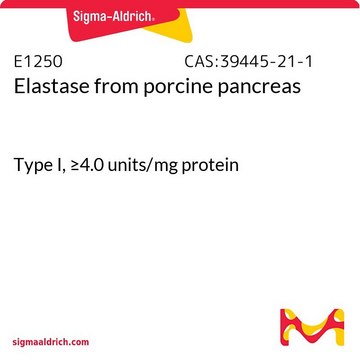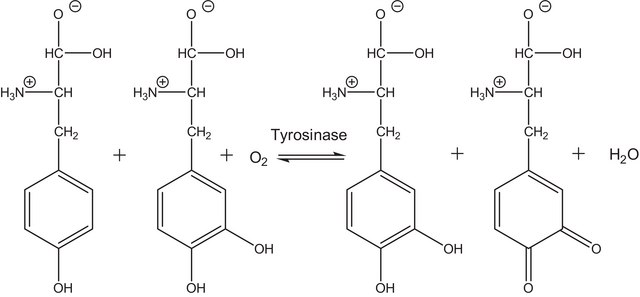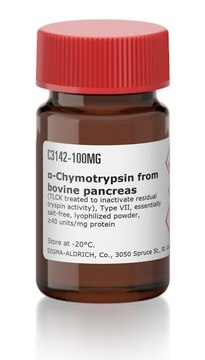E0258
Elastase from porcine pancreas
Type IV, Protein 50-90 %, lyophilized powder, ≥4.0 units/mg protein (biuret)
Synonym(s):
Elastase from hog pancreas, Pancreatopeptidase E
Sign Into View Organizational & Contract Pricing
All Photos(3)
About This Item
CAS Number:
EC Number:
MDL number:
UNSPSC Code:
12352204
NACRES:
NA.54
Recommended Products
biological source
Porcine pancreas
Quality Level
type
Type IV
form
lyophilized powder
specific activity
≥4.0 units/mg protein (biuret)
composition
Protein, 50-90%
foreign activity
trypsin ≤50 BAEE units/mg protein
storage temp.
−20°C
Looking for similar products? Visit Product Comparison Guide
Related Categories
General description
Elastase is a single polypeptide chain of 240 amino acid residues and contains four disulfide bridges. The molecular mass is approximately 25.9 kDa. The enzyme is synthesized as an inactive zymogen, proelastase, which is converted to the active form by limited proteolysis at the N-terminal by trypsin.
Application
Elastase from Sigma has been used to examine the extent of proteolytic degradation of BSA that is treated with hydroxyl radical. It has also been used to purify elastase-inhibitory lipid derivative from a cyanobacterium, Microcystis Ku2.
Elastase from porcine pancreas has been used in a study to assess the molecular bases for human leucocyte elastase inhibition. Elastase from porcine pancreas has also been used in a study to investigate the molecular cloning and expression of serum calcium-decreasing factor (caldecrin).
Elastase from porcine pancreas has been used:
- to treat vero cells to study its effects on syncytium formation
- as a positive control in protease assays
- as a component in RPMI 1640 to isolate human aortic smooth muscle cells (HASMCs) from the aortic tissue
Biochem/physiol Actions
Elastase hydrolyses elastin, the specific protein of elastic fibers, and digests hemoglobin, casein and fibrin.
Elastase is a serine protease with broad specificity as it cleaves protein at the carboxyl side of small hydrophobic amino acids such as Ile, Gly, Ala, Ser, Val and Leu. The enzyme also hydrolyzes amides and esters such as N-Benzoyl-L-alanine methyl ester. The pH optimum is found to be 8.0-8.5. It does not require any activator, but it is inhibited by diisopropyl fluorophosphate, phenylmethanesulfonyl fluoride, α2-macroglobulin, α1-antitrypsin, sulfonyl fluorides and p-dinitrophenyl diethylphosphate and high salt concentrations. It is extensively used in tissue and cell dissociation procedures. Elastase is effective in the isolation of Type II lung cells. Elastase hydrolyses elastin, the specific protein of elastic fibers, and digests hemoglobin, casein and fibrin.
Elastase is a serine protease with broad specificity as it cleaves protein at the carboxyl side of small hydrophobic amino acids such as Ile, Gly, Ala, Ser, Val, and Leu. The enzyme also hydrolyzes amides and esters such as N-Benzoyl-L-alanine methyl ester. The pH optimum is found to be 8.0-8.5. It does not require any activator, but it is inhibited by diisopropyl fluorophosphate, phenylmethanesulfonyl fluoride, α2-macroglobulin, α1-antitrypsin, sulfonyl fluorides and p-dinitrophenyl diethylphosphate and high salt concentrations. It is extensively used in tissue and cell dissociation procedures. Elastase is effective in the isolation of Type II lung cells.
Packaging
Package size based on protein content
Unit Definition
One unit will hydrolyze 1.0 μmole of N-succinyl-L-Ala-Ala-Ala-p-nitroanilide per min, pH 8.0 at 25 °C.
Physical form
Contains sodium carbonate.
Preparation Note
A further purification of Type III, E 0127, by affinity chromatography to reduce trypsin activity
Application
Product No.
Description
Pricing
inhibitor
Product No.
Description
Pricing
Signal Word
Danger
Hazard Statements
Precautionary Statements
Hazard Classifications
Eye Irrit. 2 - Resp. Sens. 1 - Skin Irrit. 2 - STOT SE 3
Target Organs
Respiratory system
Storage Class Code
11 - Combustible Solids
WGK
WGK 3
Flash Point(F)
Not applicable
Flash Point(C)
Not applicable
Choose from one of the most recent versions:
Already Own This Product?
Find documentation for the products that you have recently purchased in the Document Library.
Customers Also Viewed
Our team of scientists has experience in all areas of research including Life Science, Material Science, Chemical Synthesis, Chromatography, Analytical and many others.
Contact Technical Service















